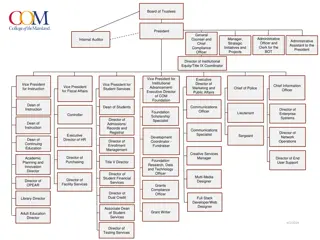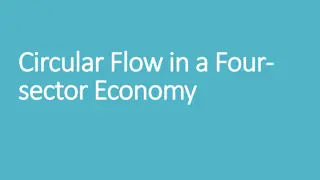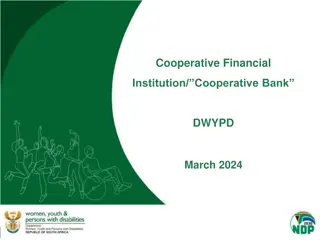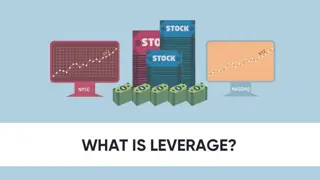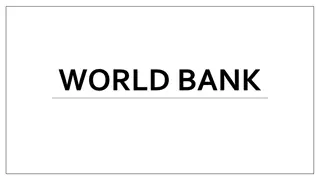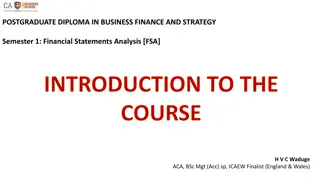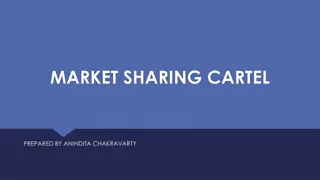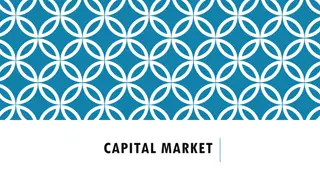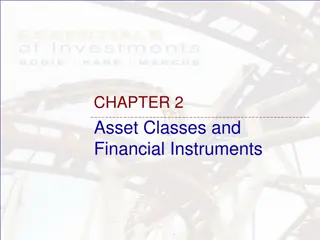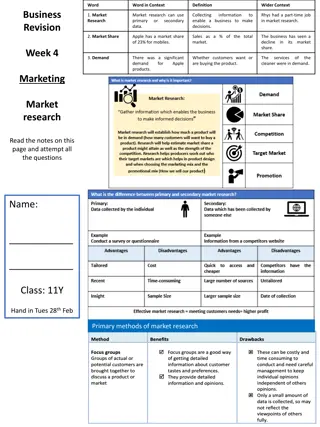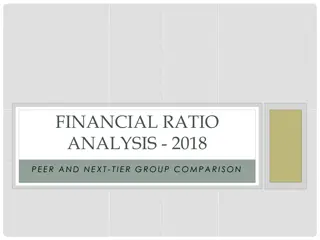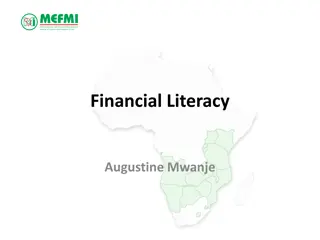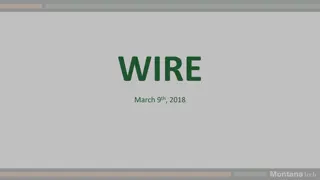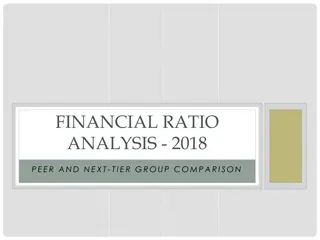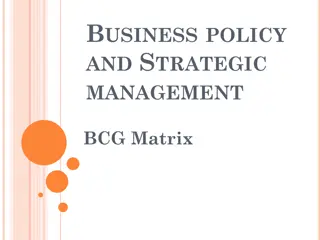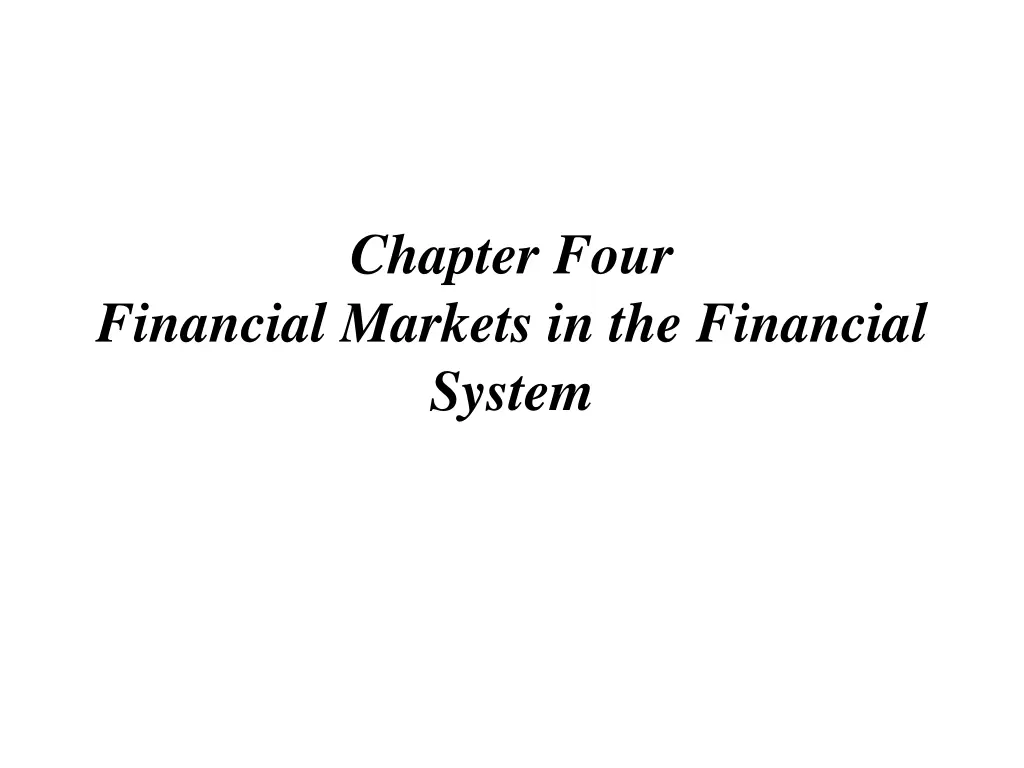
Understanding Financial Markets in the Financial System
Explore the concept of financial markets, their functions, and how capital is transferred between savers and borrowers through direct transfers, financial intermediaries, and investment bankers. Discover the roles of financial markets in facilitating the exchange of goods, services, and financial assets, enhancing income, promoting productive usage of funds, and supporting capital formation.
Download Presentation

Please find below an Image/Link to download the presentation.
The content on the website is provided AS IS for your information and personal use only. It may not be sold, licensed, or shared on other websites without obtaining consent from the author. If you encounter any issues during the download, it is possible that the publisher has removed the file from their server.
You are allowed to download the files provided on this website for personal or commercial use, subject to the condition that they are used lawfully. All files are the property of their respective owners.
The content on the website is provided AS IS for your information and personal use only. It may not be sold, licensed, or shared on other websites without obtaining consent from the author.
E N D
Presentation Transcript
Chapter Four Financial Markets in the Financial System
What is a market? A market is a place where goods and services are exchanged or a market refers to an institution or arrangement that facilitates the purchase and sale of goods & services. A financial market is a place where individuals and organizations wanting to borrow funds are brought together with those having a surplus of funds or in short a financial market is a market where financial assets are traded. Financial markets bring together people and organizations wanting to borrow money with those having surplus funds
Functions of financial markets a) Transfer of resources: Financial markets facilitate the transfer of real economic resources from lenders to ultimate borrowers. b) Enhancing income: financial markets allow lenders earn interest /dividend on their surplus investible funds, thus contributing to the enhancement of the individual & the national income. c) Productive usage: Financial markets allow for the productive use of the funds borrowed, thus enhancing the income & the gross national production. d) Capital formations: financial markets provide a channel through which new savings flow to aid capital formation of a country.
Contd a) Price determination: financial markets allow for the determination of the price of the traded financial asset through the interaction of buyers & sellers, i.e., through demand & supply. b) Sale mechanism: financial markets provide a mechanism for selling of a financial asset by an investor so as to offer the benefits of marketability & liquidity of such assets. c) Information: the activities of the participants in the financial market result in the generation and the consequent dissemination of information to the various segments of the market, so as to reduce the cost of transaction of financial assets.
Three Primary ways by which Capital is Transferred between Savers and Borrowers 1. Direct Transfer Direct transfers of money and securities occur when a business sells its stocks or bonds directly to savers, without going through institution. 2. Financial intermediary Transfers through financial intermediaries occur when a bank or mutual fund obtains funds from savers, issues its own securities in exchange, and then uses these funds to purchase other securities. any type of financial
Contd 3. Investment bankers Transfers through an investment banking house occur when the investment bank serves as a middleman and facilitates the issuance of securities. These middlemen help corporations design securities that will be attractive to investors, buy these securities from the corporations, and then resell them to savers in the primary markets.
Types of financial market There are many different financial markets in a developed economy, each dealing with a different type of instrument and a different set of customers.
Primary Vs Secondary market Primary market: Primary markets are the markets in which corporations sell newly issued securities to raise capital. The middleman in the primary market is called an investment banker (it provides underwriting function)
Contd Companies raise new capital in the primary market through: a) Public issues b) Right issue c) Private placement
Contd a. In public issue/ offering: companies sell new securities to the public (to all individuals and institutions). b. In right issue: Offering of securities may be made only to the existing shareholders. Thus, when securities are offered only to the company s existing shareholders, it is called right issue. c. Private placement: Instead of public issue of securities, a company may offer securities privately only to a few investors. This is referred to as private placement. The investment bankers may act as a finder, that is, the bank locates the institutional buyer for a fee.
Contd Secondary Market: Secondary market refers to a market where securities are traded after being initially offered to the public in the primary market and/or listed on the Stock Exchange or Secondary markets are the markets in outstanding) securities are traded among investors. Secondary market comprises of equity markets and which existing (already the debt markets.
Functions of Secondary market It provides regular information about the value of a security to the issuer of the security It provides the opportunity for the original buyers of the asset to reverse their investment by selling it for cash. It brings together many interested parties & so can reduce the costs of searching for likely buyers & sellers of the assets
The difference between the Primary Market and the Secondary Market In the primary market, securities are offered to public for subscription for the purpose of raising capital or fund. In the secondary market already existing/pre-issued securities are traded among investors. In the secondary market the issuer of the asset does not receive funds from the buyer unlike primary market, rather, the existing issue changes hands and funds flow from the buyer of the asset to the seller in secondary market.
Money vs. Capital market Money markets are the markets for short-term, highly liquid debt securities, those securities that mature in less than one year. Characteristics of money market - Short term funds are borrowed & lent - No fixed place for conduct of operations - Dealings may be conducted with or without the help of brokers.
Contd - Funds are traded for a maximum period of one year. - Liquid - Low expected return - Low degree of risk
Objectives of money markets a) Providing an equilibrium mechanism for ironing out short-term surplus & deficit. b) Providing a focal point for central bank intervention for influencing liquidity in the economy. c) Providing access to users of short term money to meet their requirements at a reasonable price.
Securities Traded in Money Markets Call money market Treasury Bills. Certificate of Deposit (CDs). Commercial Papers.
Capital Market Capital markets are markets that trade equities (stocks) and debts (bonds) instruments with maturities of more than one year. Given their longer maturity, these instruments experience wider price fluctuations in the secondary markets in which they trade than do money market instruments. For example, their longer maturities subject these instruments to both higher credit (bankruptcy) risk and interest risk than money market instruments.
Contd Capital market securities have a higher expected return and more risk than money market securities Securities traded in the capital market 1. Bonds and Mortgages: Bonds are long-term debt obligations issued by corporations and government agencies Mortgages are long-term debt obligations created to finance the purchase of real estate Bonds and mortgages specify the amount and timing of interest and principal payments
Contd 2. Mortgage-Backed Securities Mortgage-backed securities are debt obligations representing claims on a package of mortgages. The investors who purchase these securities receive monthly payments that are made by the homeowners on the mortgages backing the securities.
Contd 3. Stocks: Stocks (equity) are certificates representing partial ownership in corporations Investors may earn a return by receiving dividends and capital gains Stocks have a higher expected return and higher risk than long-term debt securities They are classified as capital market securities because they have no maturity and therefore serve as a long-term source of funds.
Organized Vs over-the-counter markets (OTC) A visible market place for secondary market transactions is an organized exchange- Auction market (eg., NYSE, BSE etc) Some transactions occur in the over-the- counter (OTC) telecommunications network) eg., Nasdaq market (a
Foreign Exchange Market The foreign exchange market is a market where foreign currencies are bought and sold. The foreign exchange market is an over-the-counter market. That is, it does not denote a particular place where dealers assemble and transact foreign currencies Major Participants Individuals Firms Banks Government International agencies
Derivative Market Derivative is a tradable financial instrument or product whose value depends on the value of some underlying asset. Very often, the underlying derivatives are the price of the traded asset. For example, a stock future is a derivative whose value depends on the price of the stock.
Contd Risk Management is most important function of derivatives. Risk management is not about the elimination of risk rather it is about the management of risk. Financial derivatives provide a powerful tool for limiting risks organizations face in the ordinary conduct of their businesses. Derivatives shift the risk from the buyer of the derivative product to the seller and as such are very effective risk management tools. that individuals and
Types of Derivatives A. Forwards: an agreement that obligates the holder to buy or sell an asset at a predetermined delivery price during a specified future time. In other words, a contract made today for delivery of an asset at a pre-specified time in the future at a price agreed upon today B. Futures: A futures contract is an agreement between two parties to buy or sell an asset at a certain time in the future at a certain price. Futures contracts are special types of forward contracts in the sense that the former are standardized exchange.
Comparison between forward contract and future contract Forward Contract Future Contract Private contract between two Traded on an exchange parties Not standardized Standardized contract Usually one specific delivery Ranges of delivery date date Settled at the end of contract Settled daily Some credit risk No credit risk
Contd There are two positions in forward contract: 1. Long position: A party assumes a long position agrees to buy the underlying asset on a specified date for a specified price. That is, it is a position of owning the underlying asset that a long position holder plans to sell in the future. It is long the good.
Contd 2. Short position: Party assumes a short position agrees to sell the underlying asset on a specified date for a specified price. That is, it is a position of expecting to purchase or borrowing the underlying asset in the future in order to deliver to the long position holder.
Example A wheat farmer has just planted a crop that is expected to yield 500 quintals. To eliminate the risk of a decline in the price of wheat before the harvest, the farmer can sell 500 quintals of wheat forward. Dire Dawa food complex factory may be willing to take the other side of the contract. The two parties agree today on a forward price of Birr 850 per quintal, for delivery four months from now when the crop is harvested. No money changes hands now. In four months, the farmer delivers the 500 quintals of wheat to Dire Dawa food complex factory in exchange of Birr 425,000.
Contd Payoffs from forward contract. Consider the position of Dire Dawa Food complex in the trade. The contract obligates Dire Dawa food complex to buy 500 quintals for Br 850 per quintal and again obligates the farmer to sell 500 quintals of wheat at the same price at the end of the fourth month. If the spot price of wheat rose to say Br 900 per quintal at the end of 4 month, the forward contract would be worth Br 25,000 (Br 450,000 Br 425,000) to Dire Dawa food complex factory
Contd The contract enable Dire Dawa food complex to purchase 500 quintals of wheat at Br 850 per quintal rather than at Br 900. Similarly, if the spot exchange rate fell to Br 800 at the end of 4 months, the forward contract would have a negative value to Dire Dawa food complex of Br 25,000 because it would lead to the Dire Dawa food complex paying Br 25,000 more than the market price for the wheat.
Contd In general, the payoff from forward contract can be calculated for long and short position holders as follows: For long position holder: Payoff = ST K For short position holder: payoff = K ST Where, K is the delivery price and ST is the spot price of the asset at maturity of the contract
Contd C. Options: An Option is a contract which gives the right, but not an obligation, to buy or sell the underlying at a stated date and at a stated price. While a buyer of an option pays the premium and buys the right to exercise his option, the writer of an option is the one who receives the option premium and therefore obliged to sell/buy the asset if the buyer exercises it on him. Options are of two types - Calls and Puts options:
Contd Calls give the buyer the right but not the obligation to buy a given quantity of the underlying asset, at a given price on or before a given future dates. Puts give the buyer the right, but not the obligation to sell a given quantity of underlying asset at a given price on or before a given future date.
Contd Options may also classified as: America Option: It can be exercised at any time up to the expiration date. European Option: It can be exercised only on the expiration date.
Example: Call option Assume that an investor buys a European call option with a strike price of Birr 100 per share to purchase 100 shares of NILE Company for a cost of Birr 5 per share. The expiration date of the option is in 90 days. The current price of the stock is Birr 98. a. What would be the total transaction cost? b. In what condition an investor exercise his right? c. What would be the net profit or loss if the price of the stock is Birr 104 and 107 on the expiration date? d. What would be the maximum net loss of an investor if he does not exercise his right?
Solution a. Total transaction cost = Transaction cost per share Number of share = Birr 5/ share 100 shares = Birr 500 b. Since the holder of the call option is hoping that the price of the underlying asset will increase, it should always be exercised at the expiration date if the stock price is above the strike price. (i.e., above Birr 100).
Contd c. Net profit or loss = Total revenue Total cost Total Revenue = Selling price Number of share = Birr 104/share 100 shares = Birr 10,400 Total cost = Purchase cost + transaction cost = ( Birr 100/ share 100 shares) + Birr 500 = Birr 10,000 + Birr 500 = Birr 10,500 Net loss = 10,400 10,500 = (Birr 100) d. The maximum loss will be equal to total transaction cost. Thus, it is Birr 500.
Example: Put option Assume that an investor buys a European put option to sale 100 shares of Y-company with a stick price of Birr 70. The price of an option to sell on share is Birr 7 per share. The current stock price is Birr 65 and the expiration date is in 3 months. a. What will be the total transaction cost or initial investment? b. At what share price an investor exercise his right? c. What would be the net profit /loss, if the stock price is Birr 72 and Birr 61 on the expiration date?
Solution a. The transaction cost = Birr 7 /share X 100 shares= Birr700 b. An investor will exercise his right, when the stock price is below Birr 70 on the expiration date. c. Assumption 1. Stock price is Birr 72 Since the stock price is greater than the exercise /strike price on the expiration data, exercising the right will increase the total loss. That is, exercising the right will increase the total loss to Birr 900. However, if an investor does not exercise his right, his net loss will be only the transaction cost, i.e. Birr 700. Thus, an investor shall not exercise.
Contd Assumption 2. Stock price is Birr 61 Since the stock price is less than the exercise /strike price on the expiration date, an investor can buy 100 share of Y-company for Birr 61 /share and sell the same share for Birr 70 under the terms of the put option. As a result, the net gain is Birr 200. Total cost = (Birr 61/share X 100 share) + (Birr 7/share X 100 share) = Birr 6100 + 700 = Br. 6800 Total revenue= Birr 70/share X 100 share = $ 7000 Net gain = 7000 6800 = Birr 200
Reading assignment Explain the difference between future and option?
Contd D. Warrants: Options generally have lives of up to one year. The majority of options traded on exchanges have maximum maturity of nine months. Longer dated options are called Warrants and are generally traded over-the counter E. Swaps: Swaps are private agreements between two parties to exchange cash flows in the future according to a prearranged formula. They can be regarded as portfolios of forward contracts. The two commonly used swaps are :
Contd Interest rate swaps: These entail swapping only the interest related cash flows between the parties in the same currency or it refers to exchanging of fixed rate obligation with floating rate obligation. Currency swaps: These entail swapping both principal and interest between the parties, with the cash flows in one direction being in a different currency than those in the opposite direction or it refers to the agreement to exchange currency differentials.
Example: Interest Rate Swap If company A issues bond to Mr x at a floating rate and on the other hand company B issues issues bond to Mr y at a fixed interest rate obligation and if later the cash flow of company A is stable where as the cash flow of company B is fluctuating, both companies can enter interest rate swap in order to avoid interest rate risk (i.e company Ashould pay fixed interest to Mr B and company B pays floating rate to MrA).
Example: Currency Swap Assume that Mr x who is living in US wants to invest in Ethiopia by borrowing dollar in US and again assume that Mr y who is an Ethiopian investor wants to invest in US by borrowing in Ethiopia. In this case the two parties enter currency swap to avoid foreign exchange risk b/c both parties are required to pay interest rate and principal amount in terms of their respective country currency, so by exchanging the payment of interest and principal amount, they can avoid currency risk (i.e. Mr x pays for Mr y and Mr y pays for Mr x b/c both parties are earning with respect to the currency of their investing country)
Pricing of Derivatives 1. Pricing of Futures The relationship between futures price and spot price can be written in terms of cost of carry. "Cost of Carry includes storage costs, transportation costs, insurance costs, opportunity costs as well as interest/dividend receipts and other opportunity benefits. Futures Price = Spot (Cash) Price + Cost of Carry interest costs, other
Contd 2. Pricing of Options The price of the option is known as the premium. Option Premium is the price the buyer has to pay the seller to purchase the right to buy/sell the asset at the strike price. Option premiums can be divided into two components: time value and intrinsic value. Option Premium = Intrinsic Value + Time Value
Contd Intrinsic Value The amount an option holder can realize by exercising the option immediately. Intrinsic value refers to what the option is actually worth. Intrinsic value is always positive or zero. 1. Intrinsic value of a Call Option = underlying product price - strike price 2. Intrinsic value of Put Option = Strike price - underlying product price


